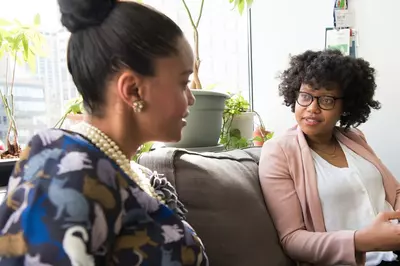
 Sasha met Nicole and Esha during their freshman year, quickly becoming close friends over dorm food and late-night study sessions. The next year, the three decided they would rent an apartment together. Things were going pretty well up until midterms week when dirty dishes started to pile up in the sink. Sasha began to feel annoyed at her roommates. She enjoyed cooking meals for herself, but the rising pile of dishes in the sink along with the dwindling amount of clean silverware made it difficult for her. One morning, she came downstairs after pulling an all-nighter to prepare a bowl of cereal and realized that they had no clean spoons. Frustrated and exhausted, she returned to her room without breakfast, slamming her door and startling her roommates.
Sasha met Nicole and Esha during their freshman year, quickly becoming close friends over dorm food and late-night study sessions. The next year, the three decided they would rent an apartment together. Things were going pretty well up until midterms week when dirty dishes started to pile up in the sink. Sasha began to feel annoyed at her roommates. She enjoyed cooking meals for herself, but the rising pile of dishes in the sink along with the dwindling amount of clean silverware made it difficult for her. One morning, she came downstairs after pulling an all-nighter to prepare a bowl of cereal and realized that they had no clean spoons. Frustrated and exhausted, she returned to her room without breakfast, slamming her door and startling her roommates.
Conflict occurs when you and someone else have differing values, beliefs, or opinions about a situation. Despite the uncomfortable feelings it can evoke, conflict is a normal part of the human social experience. Just think about how differently each person sees the world. Living among other people will inevitably lead to some friction. It’s important to address conflict to prevent it from growing into a deeper issue as unresolved conflict can show up in other ways, affecting the quality of your connection. Conflict is not always negative—in fact, it can be extremely beneficial for relationships to encounter conflict and work through to a resolution.
 What is mindful communication?
What is mindful communication?
“Mindful communication brings awareness to both the internal and external aspects of communication and how they interact,” explains Dr. Douglas Kennedy, mindfulness teacher and assistant professor at the University of Minnesota Earl E. Bakken Center for Spirituality & Healing. The external aspects of communication include listening and speaking, which are what most communication systems tend to focus on. Mindful communication, importantly, acknowledges the internal aspects of human experience. These can include thoughts, emotions, goals, complex personal and cultural history, and any other dimension of being that can affect the way we view a situation.
“Being able to bring awareness to emotions, patterns of thought, and the ways they may be affecting what we are experiencing can be helpful in de-escalating, focusing on resolving the conflict, and preserving the relationship,” continues Kennedy. Mindful communication involves approaching conflict as an opportunity to better understand the experiences of those involved. It acknowledges the complexity of each individual and holds space for disagreement.
Before you act
Some of the most important work in handling conflict happens internally. Before you act, take a moment of mindfulness to observe your emotions and how they are showing up in your body.
- What emotions are you feeling? Try a Feelings Wheel to find the precise word for what you are experiencing.
- How does your body feel? Some people experience shallow breathing and a tightness in their stomach or chest. Flushed cheeks and shaky hands are also telltale signs of a reactive state. Try a body scan meditation to identify these sensations.
- How ready are you to hear what the other person has to say? Are you wanting to prove a point or change the other person? Neither of these is an effective way to handle conflict. Mindful communication is about being open and non-judgmental towards their experience as well as your own.
Take a pause
While you may want to try to address the situation as soon as it comes up, a more useful practice to develop for yourself is emotional containment. Emotional containment means holding onto whatever strong emotions you may be experiencing without acting on them immediately. It means giving yourself the time and space to process the things you are experiencing so you can make wise choices about what to do with them.
“When we are in conflict or feeling under stress, our bodies can get flooded with neurotransmitters and hormones that prepare us to fight or flee,” explains Kennedy. These chemicals kept our species safe for centuries, giving us the ability to act fast in dangerous situations. In our modern lives, however, conflict is rarely life-threatening, and these neurochemical reactions can hinder our ability to engage with a situation in a thoughtful way.
“Taking time to let your system settle and allow these chemicals to metabolize can be really helpful,” continues Kennedy. “Mindfulness facilitates the ability to check in with yourself and determine if you are still in a heightened state.” Remember: There is no rush. Oftentimes we forget that we have the choice to decide when to engage. This is a crucial step in managing your conflict, so take as much time as you need to return to your emotional baseline.
One last thing to do before starting a conflict conversation is to check in with yourself about your assumptions. Oftentimes we hold strong assumptions about how others are thinking and acting without even realizing it ourselves.
These assumptions can be based on how someone has behaved in the past, fueling an interpretation of their present self that may not be fully accurate. Other times, assumptions arise from our own rationale—thinking that others would apply our own method of reasoning in a situation. The main thing about assumptions is that they are unverified explanations based on what we think we know. As difficult as it may be to separate our thoughts from reality, it’s imperative to practice, especially when it comes to our close relationships.
A liberating thing to realize is that things are rarely personal. People typically do things because they seem like the best option for them at the time, given their current headspace and understanding of the world. Depersonalizing conflict will save you time and suffering and help you find constructive ways forward.
- 1 of 3
- 2 of 3
- 3 of 3
Having a conversation
Here are some tips for having a conversation once you are ready to address conflict.
- Preview the conversation. Just as you gave yourself time to cool down and contemplate, give the other person some time to collect their thoughts on the topic. While it might feel awkward to give someone a heads-up for a potentially difficult conversation, it’s better than blindsiding them and triggering a heated response.
- Set the tone for collaboration. Make it clear that the conversation is not about finding blame or fault, but rather to grow understanding so the relationship can succeed.
- Find areas of agreement. While the process of addressing conflict can put a spotlight on your differences, a simple and effective way to build rapport through an uncomfortable conversation is to acknowledge your areas of agreement.
- Be intentional with your phrasing. “I” statements, such as “I feel,” “I believe,” or “I need,” are a powerful way to express yourself without escalating the conflict or causing the other person to become defensive.
- Ask questions. The main goal of a conflict conversation is to gain information and perspective to assemble a more holistic view of the situation. Ask questions that will further the conversation towards understanding.
- Know when to step back. You both may have started the conversation with all the best intentions, but if it veers off into heated, defensive, or argumentative territory, it may be time to take a break.
 And those cohabitating sophomores?
And those cohabitating sophomores?
Sasha gave herself some time to cool down over the weekend by spending it at her parents’ house. She texted their group chat, “Hey, when I get back on Sunday can we have a house meeting about our dish situation?” When she returned, the three had an honest conversation about their stress levels and how it affected them at home. The girls had different ways of dealing with the pressure from midterms: when Nicole and Esha got stressed, they would let dishes pile up, while Sasha preferred to manage her stress by cooking nutritious meals for herself at home—which she couldn’t do given the current dish situation. The girls resolved to keep the sink clean for the sake of their friend, and left the conversation with a richer understanding of each others’ inner lives.
More Student Wellbeing articles Student Wellbeing provides resources specific to college students and their wellbeing, especially around issues like stress, mental health, addiction, financial obstacles, and other barriers that prevent them from thriving at university and in life.


